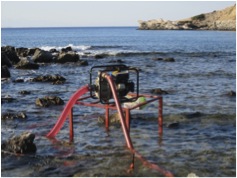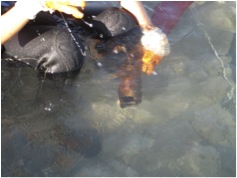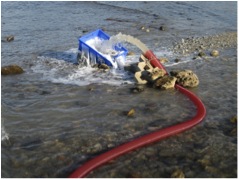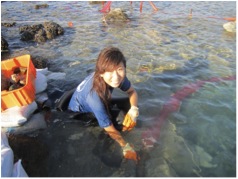(Guest post by Tyler Laughlin)
One of the benefits of performing an excavation in shallow water rather than land is the ability to utilize simple water dredges for removing sediment and small stones. While the shovel and trowel can never be replaced as necessary tools for an excavation, the water dredges have greatly enhanced the productivity of our 2013 excavation team. For our trusty dredges, thanks are due to our own Troy Nowak and INA’s Murat Tilev, who creatively adapted the fantastic dredge parts manufactured by Keene Engineering to work with equipment available locally in Turkey.
The only items necessary to make a water dredge are a water pump, three hoses, and a Venturi tube. Water is drawn up through an intake hose equipped with a one-way filter to prevent backflow and to keep debris out of the water pump. The pump draws in the water and expels it down another hose that becomes constricted in flow over distance. The reduction in diameter creates the Venturi effect where the velocity of the water increases as it enters a constricted area. It also lowers the static pressure behind the flow creating a vacuum.
We utilize the Venturi effect through a metal pipe with an angled attachment for the water from the pump to flow into. The working end of the dredge is attached to the end of the Venturi tube that is closest to where the compressed water flow enters. This is where the pressure is lower and causes suction for the dredge to act like a vacuum, taking up loose sand, sediment and small stones. The compressed pump water and working end fluid flow through the Venturi tube out the opposite end where an exhaust hose is attached to move unwanted materials away from the excavation trench.
The dredge is not a perfect machine and has its own set of logistical problems. The actual pump needs to be properly maintained to function and, ironically, cannot get wet. Pumps must be secured onto tables before a dredge is started. Also, large rocks and other debris can clog the dredge causing it to fail.
Despite some of the problems that can accompany using the water dredges, they streamline the excavation process in shallow water. We would not be making nearly as much progress this 2013 season without the water dredges.







